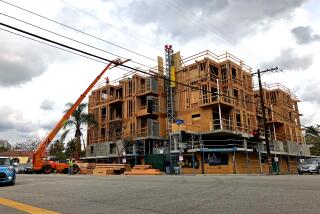Council Approves Builder Fees for Inner-City Neighborhoods
- Share via
Developers who build homes in already-developed San Diego neighborhoods will now pay the city from $800 to $4,430 per residential unit to help finance streets, libraries, parks and fire stations.
The San Diego City Council on Monday approved the new residential development fees, making good on one of its pledges during the recent months of debate over how to harness what some say is runaway growth.
The lowest of the 13 inner-city area fees approved Monday were for Uptown, which includes portions of Mission Hills and Hillcrest. There, a developer will have to pay the city $800 for every home, condominium or apartment unit that is built.
The highest fee is in Mission Valley, with a $4,430 assessment for every residential unit.
Other fees include $2,270 a unit in Pacific Beach; $2,240 in the Tijuana River Valley; $1,820 in Golden Hill; $2,430 in Southeast San Diego; $1,145 in Linda Vista; $1,880 in the Mid-City area, which includes Normal Heights and Kensington, and $1,920 for North Park.
Take Effect in 60 Days
City Atty. John Witt said Monday that the ordinance--and its fees--would go into effect in 60 days. City officials said any developer who, starting today, applies for residential permits in the affected areas would be subject to the new fees; projects already in the planning “pipeline,” however, would be exempt.
Under the city’s 1979 Growth Management Plan, development fees were imposed on residential and commercial development in the outlying suburban areas to help pay for parks and other public amenities. The fees were instituted after Proposition 13 severely cramped the city’s ability to pay for the public facilities through property taxes.
But the Growth Management Plan specifically refrained from imposing development fees in the so-called “urbanized” areas, or inner-city neighborhoods. City officials hoped the lack of fees would spur redevelopment by inducing developers to tear down older buildings and replace them with newer structures.
Over the years, however, that plan has worked too well, city officials now admit, and the glut of inner-city construction has resulted in overcrowded roads and schools and overburdened sewers.
For example, there are only 10 acres of park land in the North Park area for 57,000 residents--a ratio that is well below what is considered acceptable by city standards, city officials say.
In June, during discussion of the Interim Development Ordinance, council members agreed that it was time to impose development fees in the urbanized areas to pay for what was sorely lacking in public facilities.
Commercial Fees?
In addition to fees for residential construction, council members are debating whether to impose fees for industrial and commercial development in inner-city neighborhoods. Council members delayed until Sept. 14 any action on that proposal.
Council members also put off until today a decision on whether to exempt large commercial developments in Mission Valley from paying any fees. The developers of these prime parcels of real estate have already signed special contracts with the city to provide millions of dollars of public improvements on and around their property.
Councilman Ed Struiksma, whose council district includes Mission Valley, asked for the exemption for the so-called North Side development, which covers 241 acres immediately west of San Diego Jack Murphy Stadium, as well as for landowners involved in the First San Diego River Improvement Project.
The project, known as FSDRIP, involves four prominent landowners: Sammis Properties, CalMat Properties, Crow-Hazard Properties and C. Dennis Marteeny. The landowners have agreed to back $24 million in public bonds to channel the river from California 163 east to Stadium Way Road. The group also has promised to pay an additional $16 million in off-site public improvements, said Rebecca Michael, an attorney for the group.
If the city imposes development fees on commercial development, it would cost FSDRIP property owners an additional $30 million, Michael said. The added costs may make the development plans infeasible, the landowners testified Monday.
Struiksma said both projects “more than bit off their fair share of the apple the first time” by already agreeing to pay for millions of dollars in public improvements. “Then we come along and say, ‘Hey, we want more money.’ ”
Mayor Maureen O’Connor delayed the question of what to do with the exemptions requested by Struiksma until today so that city staff members could check on the landowners’ claims.
More to Read
Sign up for Essential California
The most important California stories and recommendations in your inbox every morning.
You may occasionally receive promotional content from the Los Angeles Times.










